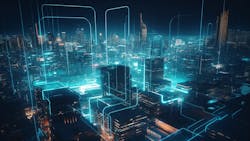Digital twins inch closer to reality in building construction
Digital twins are complex in terms of technology and execution, but at their essence, their intent is straightforward. A digital twin is a virtual model that accurately replicates the behavior of a physical entity, says Zahra Ghorbani, BIM manager and doctoral candidate at Pennsylvania State University and vice chair of the National Institute of Building Sciences Digital Twin Integration Subcommittee (NIBS DTI-S). “The physical entity could be a single building asset, a building system, a building, or even a city.”
It could be argued that NASA used a proto version of digital twins as far back as the Apollo program of the 1960s, when earthbound versions of spacecraft were built to simulate and test responses to potential challenges and crises in a safe environment. But our modern understanding and use of the term “digital twin” came forward in the early 2000s, when it was first applied to manufacturing. In the intervening years, the concept has grown to other industries, including building design, construction, and operation.
We live in a world awash in data, but without context and framing, the raw data is overwhelming and practically useless. Digital twins can help analyze and process performance data from the past, present, and future to better understand and optimize outcomes. “In architecture, a digital twin is an electronic 3D representation of a space that has live data attached to show information,” explains Islay Burgess, a New York–based principal and regional design technology director at Gensler. “This could be the air quality in every room of an office, industrial machinery in use, or monitoring that ensures optimal temperatures are maintained for performance.”
We live in a world awash in data, but without context and framing, the raw data is overwhelming and practically useless.
At any point in a building’s life cycle, digital information exists to describe its makeup and function. In the design and construction phase, building information models provide virtual snapshots of the components and systems in the building. In operation, myriad sensors and monitors deliver environmental and systems data to facilities managers.
“Twin technology is the marriage of digital transformation and decision support,” says Patrick Wallis, director of the Built Environment Innovation Lab at Esri. Based on the OODA loop, a theoretical model developed by Air Force Col. John Boyd in the 1950s, observation of information can change the orientation of the environment, which changes the view of the next decision and action. “It’s a continuous feedback loop,” Wallis says. “A digital twin leverages technology to connect these aspects of decision-making and action-taking together.”
Types of digital twins
Digital twins can be categorized in many ways within the building industry; generally speaking, they are divided into four or five groups, with increasing degrees of sophistication. Software developer Autodesk, for example, classifies digital twins by the five following levels.
- Level one: Descriptive twin. This is a live, editable replica of a built asset, assembled from design and construction data. BIM and 3D models are examples. Users directly control the data that goes in and what they want to extract. A descriptive twin is helpful in the building design and construction phase, enabling deeper understanding and modeling of integrating different materials and systems in the building.
- Level two: Informative twin. By integrating with sensors and operations data from the building, informative twins enable real-time insight for building operators and facilities managers, allowing them to make more informed decisions and increase operational efficiency.
- Level three: Predictive twin. Building on the informative twin, the predictive twin interacts with operational data and provides deeper insights to operators. Through contextual data and analytics, it identifies potential issues in a building or system and can inform facilities managers about problems or required regular maintenance.
- Level four: Comprehensive twin. This future-forward twin uses advanced modeling and simulation to play out potential scenarios while providing analytics and recommendations for dealing with different types of issues. This tool can run endless hypotheticals in a safe, virtual environment.
- Level five: Autonomous twin. This type adds artificial intelligence (AI) to the mix. An autonomous twin can learn and make decisions using advanced algorithms for simulation and 3D visualization. It puts the heavy analysis and action in the hands of AI, rather than of operators or designers.
Each type of digital twin provides its users nearly endless possibilities. How they are used depends largely on the data available and what the user is trying to learn. “A true digital twin is many systems working together,” says Troy Harvey, CEO of PassiveLogic, a building control technology company based in Holladay, Utah. “You can go to an object and access data histories and even simulate and deduce future outcomes.”
Architectural applications
Much of the BIM and 3D modeling technology currently behind digital twins was developed for building design and construction. Engineers and architects have become increasingly comfortable working in digital environments. “BIM allows an immersive experience of unbuilt spaces,” Burgess says.
In a new build project, a digital twin can emerge and live alongside its physical counterpart, layer in input from operational data and Internet of Things (IoT) devices. It removes traditional systems silos and establishes the foundation for a true smart building.
“The traditional BIM world is a linear process,” explains Kimon Onuma, an architect in Pasadena, Calif., and team lead of the Data Framework Work Group at NIBS DTI-S. “Imagine a railroad with stations along the way. You go into different phases of the project and pass information on to the next team. A digital twin is more like a road system, or networks or utility systems that connect everything. It’s … a network of roads where you can go anywhere. It’s a system of systems with many talking to each other.”
Facilities management
For facilities managers, digital twins enable more operator-centric environments and tools to deal with the real-time challenges of running complex buildings. Different building systems and management programs can talk to each other. Through predictive simulations, building operators can plan for challenges they may encounter in the physical building. The twin provides a virtual environment to work out problems in advance and to optimize the performance of the physical building.
“We recognize that operations professionals require a very different experience,” explains Robert Bray, vice president and general manager of Autodesk Tandem, a digital twin solution. “The facility monitoring experience starts with curated dashboards that provide a broad view of data that matters to them. … From the dashboard, a user can drill into an anomaly to investigate the potential issues, examine the data in detail, and navigate complex data with ease. The trick is to clarify the outcomes you hope to achieve and to define your data requirements. Having the normalized asset, space, system, and IoT data across your portfolio is a critical input to future predictive analytics and AI that deliver long-term value.”
Adding AI into the technology mix
AI is poised to play a significant role in the growing utility of digital twins. Beyond modeling and presenting information about building status and operations, AI can make real-time adjustments and run efficiency optimizations quickly, supplementing and augmenting the work of facilities managers.
“As buildings become more complex, AI becomes another partner in the room and another consultant we work with,” Onuma says. “We can feed specific requests or rules to an AI-enabled digital twin or ask questions about assets of hundreds of buildings in a portfolio.”
“As buildings become more complex, AI becomes another partner in the room and another consultant we work with.”
“An ordinary 100,000-square-foot commercial building has about 5,000 input/output (IO) points, meaning IoT, sensor, and controllable points,” Harvey says. “For comparison, a self-driving car has about 100 sensors, and controls that can do three things: steer, stop, and accelerate. The car presents a difficult challenge in a chaotic environment, but what about a building? The biggest buildings have closer to 1 million IOs, which is orders of magnitude more complex. It’s a whole fleet of subsystems that need to be controlled in a multidimensional space. For this, AI can provide useful insights, information, and action.”
Digital twins in action
Today, digital twins are used in the design and operation of many building types beyond commercial offices. According to Bray, digital twins are used in health care facilities, data centers, retail, event centers, distribution centers, water treatment facilities, transit stations, and airport terminals.
California Community Colleges’ cloud-based system FUSION (Facilities Utilization, Space Inventory Options Net) is a building and space inventory of the institution’s 5,000-plus buildings, totaling more than 90 million square feet. “FUSION is accessible in real time through their interface and with a direct API connection to get to selected data,” says Onuma, whose eponymous firm helped guide the initial implementation of the FUSION API more than a decade ago. With this connectivity, FUSION serves as a foundation for other digital twin systems. Changes to facility, building, space, and condition data in FUSION are updated in real time to the API.
As an example, he says, “with the Los Angeles Community College district’s 742 buildings, we connected their BIM and GIS data to facility management CMMS (computerized maintenance management systems) linked to FUSION, and then to their asset inventory, custodial planning, classroom scheduling, and more.” The synchronized systems then react to each other as changes happen. As a result, the California Community Colleges can do more with fewer resources in its digital twin ecosystem.
The insights that digital twins deliver can help the overall building industry’s efforts to create and operate less environmentally intensive and more efficient projects. By seeing the specific behavior and interactions of buildings in operation through the prism of real-time data, architects, engineers, and facilities managers should be better able to optimize and improve efficiency in a dynamic fashion.
At Esri’s Built Environment Innovation Lab, Wallis has been using digital twins to help decarbonize buildings. By modeling buildings in responsive virtual environments, he and his team can test ideas and discover the most effective solutions. “From the perspective of energy efficiency and passive energy potential, we looked at several things,” Wallis says. For starters: “What is the building’s relation to the sun, weather, and other buildings at any given place and time? Is it rectilinear? What is its ridge line orientation? Is it optimal east/west?”
In the quest for more sustainable and efficient buildings, digital twins provide a targeted summary visual that can help designers, builders, and operators deliver the best results possible.
“As we work toward operational carbon–negative goals for our buildings, connected devices can help track performance recalibration of the energy being used daily,” Burgess says. “This will accelerate the pace at which data can inform real-time design and operational changes.”
The built environment faces myriad challenges related to climate change. With the technology and data now at our disposal, the industry can make real strides toward facing and conquering those challenges. The predictive insights that digital twins provide can have an enormous impact in the years to come.
In the next five or 10 years, Onuma views digital twins as the only technology by which the industry can understand, connect, and collaborate on the innumerable interactions and impacts among the built and natural environments. “Digital twins are going to evolve, and it could be exciting and scary,” he says. “But it’s our chance to rise. We must innovate in any way possible to solve the complex challenges of the built and natural environment.”
About the Author

Jim Schneider
Jim Schneider, LEED AP, is a writer who has worked in and covered the design and construction industry for nearly 20 years. He writes about architecture, construction, sustainability, industry trends, and building technology.
